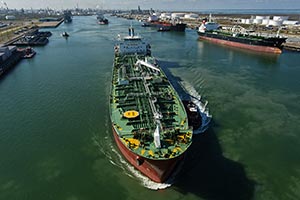Port of Corpus Christi Sizes Up Infrastructure to Better Handle Growth

It'll be weeks before Port of Corpus Christi officials know exactly how many ships sailed through their waters in 2016. One thing they've already learned: They'll need more space for customers in 2017.
The local success of international businesses, such as Austrian iron manufacturer Voestalpine Texas and Italian plastics giant M&G Resins USA, has made the Coastal Bend a magnet for industrial growth, said Jarl Pedersen, the port’s chief commercial officer.
It also has renewed efforts to deepen and widen the Corpus Christi Ship Channel for safety reasons. The long-discussed project will be key to ensuring the port is ready to handle new growth, Pedersen said.
RELATED: Panama Canal growth pushes Texas ports to improve
"It's going to be our top priority in 2017," he said.
A record 103.5 million tons of cargo, most of it petroleum, sailed through the port on more than 7,500 vessels in 2015. Port financial records show 85.9 million tons made their way through the port between January and November, down from 95 million during the same period a year earlier.
Port officials have twice gotten approval from Congress to widen the ship channel from Port Aransas to the Harbor Bridge, and to deepen it from 45 feet to 52 feet. However, they've not been awarded the estimated $350 million needed for the improvements.
Port officials lauded the passage earlier this month of the Water Infrastructure Improvements for the Nation, or WIIN, Act in Congress. It calls for cost sharing for all channel projects more than 50 feet deep.
Other infrastructure changes are planned at the port:
New oil docks under construction along the ship channel will directly benefit two port tenants — M&G Resins USA and NuStar Energy. Oil Dock 14 is being built for $24.8 million on land where M&G is constructing a 412-acre PET plant for plastics. NuStar Energy recently announced plans to expand its storage capacity near Oil Dock 15 to more than 3.6 million barrels.
Port officials are nearly finished adding more storage capacity to its 43-mile rail network. The first phase of the $18 million project created eight unit train sidings and provided rail storage for nearly 1,300 rail cars. Phase II called for more railcar spots and storage for $28 million, and will wrap up in the first quarter of 2017.
Outbound petroleum volumes for ports like Corpus Christi's are likely to increase as the energy sector begins to recover, said Ray Perryman, CEO of The Perryman Group, an economic research and analysis firm in Waco.
"Ports should be evaluating their capabilities in light of changing patterns in global shipping, as well as development of export products," Perryman said. "Improvements at the Port of Corpus Christi will certainly help position it to better meet future needs."
A survey by the American Association of Port Authorities found that ports and their private-sector partners anticipate spending $155 billion in capital projects through 2020 for port-related freight and passenger infrastructure. Of that, nearly $128 billion is expected to be spent in the Gulf.
"Bigger ships are able to move around the world more seamlessly now, especially with these infrastructure improvements in place," said Aaron Ellis, public affairs director for the association.

